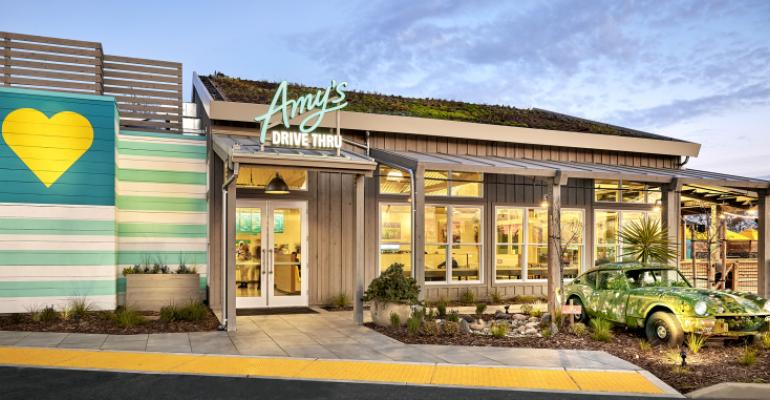Just two years ago, Amy’s Drive Thru executives shared their bold goal to grow the all-vegetarian concept from four units to 25-to-30 in the next five years. Earlier this year, the company named Paul Schiefer as president, and he’s pumped the brakes a bit on that plan.
That’s not to say he’s not ambitious about the brand, however. In fact, quite the opposite. Schiefer had spent 16 years at the company before his appointment as president, so he has a unique perspective on its inner workings.
“We’re going to grow from the basis of sustainable growth, not just to show we can do it. There are too many casualties of companies that grew in the wrong way. They didn’t build a model, playbook or team,” he said during a recent interview. “We don’t want to chase some short-term trend. We want to take our time and grow intentionally.”
Amy’s Drive Thru now includes five restaurants throughout Northern California and the immediate priority has shifted away from growth and toward an effort to get that model, playbook and team refined. Those pieces will then build on the company’s supply chain advantages, leveraging synergies with parent company Amy’s Kitchen’s organic frozen and packaged foods division that includes a presence in 43,000 grocery stores throughout the country.
“We’ve really become brand-leading, category-leading in our space. We make our own food, we’ve built an incredible network of suppliers and growers, and at the same time, we have three production facilities,” Schiefer said. “It’s a kitchen environment that feels like a big restaurant and has allowed us to scale a version of traditional cooking in our drive thru division.”
Most brands that play in both restaurants and CPG start as restaurants first. Amy’s went in the opposite direction and Schiefer believes that has also been an advantage.
“We figured out how to make good food and a great sourcing network, why not deliver that same purpose but in a different way? That is what inspired us to build a fast food restaurant in the first place,” he said.
The first Amy’s Drive Thru opened in 2015. Schiefer said it generated a “line across the parking lot” because of its differentiated position as an all-vegetarian, organic concept that sold items like burgers and pizzas, “not just sprouts and hummus.” This, he adds, was the first of four stages of the concept’s journey. “The startup phase,” he calls it.
“We weren’t even sure what any of this would look like, but we were a bit of a national sensation. There was a buzzy piece to us being the first of our kind in the fast food space,” Schiefer said.
The initial popularity was good, no doubt, but it also made the team realize that they had a lot of work to do on the operations side. In 2017, the “operational efficiency stage” became a priority and the company created an operations team with independence from the company’s retail side, which isn’t the case for other parts of the business, like food safety or finance.
“We realized quickly we had a lot of operational challenges we had to work through and evolve. The team we put together spent a lot of time building repeatable processes and training processes and made massive improvements with COGS and labor models. We put a ton of focus on building a playbook with a tech layer behind it and we were starting to nail it as we approached 2020,” Schiefer said.
That’s when the company, like much of the industry, entered its “survival phase” to get through Covid restrictions. This included putting measures in place to keep employees safe, dropping breakfast as morning commuters disappeared, improving its tech platform, launching a loyalty app, and experimenting with off-premises channels for the first time.
Now, Amy’s Drive Thru is in its fourth phase, one Schiefer said is focused on perfecting its development model. This model entails details such as “slightly smaller, leaner concepts to develop an appropriate return a scaling restaurant ought to generate,” he said. Traditional locations, for context, are between 4,000 and 4,200 square feet. New models will be almost half that. The phase also includes a sharpened focus on trade areas, a new kitchen package, station-sharing opportunities in the back-of-house, and more. Once this development phase is refined, Schiefer said, Amy’s Drive Thru will have earned the right to scale.
“Coming out of Covid, we now see ourselves reflecting on our first seven years and trying to understand how we focus on our future. We will never stop improving on our fundamentals; continuing to look for half-point margins, driving exceptional customer experience, food safety, employee experience,” Schiefer said. “There is strategic work around constantly striving for perfection.”
That said, he’s reining in that ambitious growth target and focusing on those fundamentals and is a bit apprehensive about identifying any sort of definitive growth targets. But there will most definitely be growth, he said.
“We have 2,800 people on the CPG side and about 200 on the drive-thru side and we think, eventually, we will even those two divisions out. Most of our drive thru customers come in not because they’re vegetarians or vegan or organic puritans, but because they want a great tasting meal at an affordable price,” he said. “We’re not chasing every momentary short-term trend, but rather focusing on great tasting, comfort food and we think we have a lasting concept that can be generational in nature.”
Contact Alicia Kelso at [email protected]





